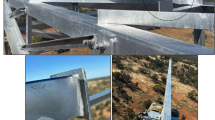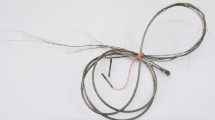Abstract
The failure of a multistrand wire rope used in drilling rig hook is investigated in this case study. The wire rope failed during the raising of the rig and caused some serious damage to the rig structure. Throughout its short time of service, the wire had been used a few times for rig up and rig down. The failure investigation is performed by metallurgical examinations and computational analyses utilizing the finite element method. The wire rope was made of AISI 1095 steel. Its chemical composition, ferrite–pearlite structure, and high hardness indicate that the wire is a type of extra extra improved plow steel (EEIPS) grade. The morphologies of fractured surfaces indicate tensile overloading of wires. Finite element analysis confirms the overload in core and strands, and compressive contact stresses between wires, and between wires and sheave surface. The results show that high tensile stresses due to the overload and small ratio of sheave-to-rope diameter were responsible for the failure.















Similar content being viewed by others
References
Steels: Processing, Structure and Performance (#05140G). ASM International, Ohio (2005)
Yilmaz, M.: Failure during the production and usage of steel wires. J. Mater. Proc. Tech. 171, 894–902 (2006)
Parameswaran, P., Raghunathan, V.S., Hiremath, S.C., Paknikar, K.R.: Failure of locked coil wire rope of coal handling system. Eng. Fail. Anal. 10, 395–404 (2003)
Torkar, M., Arzensek, B.: Failure of crane wire rope. Eng. Fail. Anal. 9, 227–233 (2002)
Mapelli, C., Barella, S.: Failure analysis of a cableway rope. Eng. Fail. Anal. 16, 1666–1673 (2009)
Singh, M.K., Mahto, A., Thakur, R.N.: Failure analysis of wire rope used for hoisting in mining: a case study. J. Fail. Anal. Prev. 7, 87–91 (2007)
Raoof, M., Kraincanic, I.: Analysis of large diameter wire rope. J. Eng. Mech. 121, 667–675 (1995)
Jiang, W.G., Henshall, J.L., Walton, J.M.: A concise finite element model for three-layered straight wire rope strand. Int. J. Mech. Sci. 42, 63–86 (2000)
Stanova, E., Fedorko, G., Fabian, M., Kmet, S.: Computer modeling of wire strands and ropes part I: theory and computer implementation. Adv. Eng. Softw. 42, 305–315 (2011)
Stanova, E., Fedorko, G., Fabian, M., Kmet, S.: Computer modeling of wire strands and ropes part II: finite element-based applications. Adv. Eng. Softw. 42, 322–331 (2011)
Miller, B.A.: Failure analysis of wire rope. Adv. Mater. Proc. 157, 6–43 (2000)
Krishnadev, M., Larouche, M., Lakshmanan, W.I., Sridhar, R.: Failure analysis of failed wire rope. J. Fail. Anal. Prev. 10, 341–348 (2000)
API, Specification for Wire Rope, API Spec 9A, 25th edn. American Petroleum Institute, Washington (2004)
Phillips, J.W., Costello, G.A.: Analysis of wire ropes with internal-wire-rope cores. J. App. Mech. 52, 510–516 (1985)
API, Recommended Practice on Application, Care, and Use of Wire Rope for Oilfield Service, RP 9B, 11th edn. American Petroleum Institute, Washington (2002)
Author information
Authors and Affiliations
Corresponding author
Rights and permissions
About this article
Cite this article
Moradi, S., Ranjbar, K. & Makvandi, H. Failure Analysis of a Drilling Wire Rope. J Fail. Anal. and Preven. 12, 558–566 (2012). https://doi.org/10.1007/s11668-012-9596-7
Received:
Revised:
Published:
Issue Date:
DOI: https://doi.org/10.1007/s11668-012-9596-7




